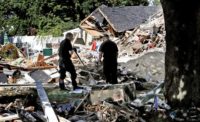Metropolitan Transportation Authority says that Metro-North Railroad has completed 14 of the 27 safety measures either mandated or suggested in the Federal Railroad Administration’s review of its operations earlier this year. The railroad has made progress on five of the measures and has a plan for eight more, MTA says.
The May 15 announcement came the same day that the National Transportation Safety Board made safety recommendations to both MTA and FRA.
Safety steps taken since last December include train speed reductions, automated track inspections and cab cameras, MTA says. It adds that it has begun to expedite implementation of positive train control, and that both Metro-North and the Long Island Railroad have begun the process to purchase and install inward- and outward-facing cameras to assist in incident investigations.
Two-thirds of Metro-North’s railcar fleet is outfitted with “alerters” to help engineer response time while operating a train. MTA says the railroad designed and procured alerters for its older railcars and aims to install them this year.
The commuter railroad has been under pressure to improve safety following several accidents in the last year. These include the derailment last December at its Spuyten Duyvil station in the Bronx that killed four and injured 50 others and another on July 18 when a CSX freight train on the railroad’s Hudson Line derailed.
The FRA conducted the 60-day safety assessment, which recommended or directed Metro-North to take action in eight categories including track safety, railroad operating rules, qualification and certification for engineers and conductors, workplace safety, train control systems, blue signal protection for employees, Operations Control Center, and track worker fatigue.
NTSB has been investigating both the Spuyten Duyvil derailment as well as the May 17, 2013 derailment and subsequent collision of two Metro-North passenger trains in Bridgeport, Conn.
In the Bridgeport accident, NTSB’s ongoing investigation found there were broken joint bars of the rail where the trains collided and that the last inspection on this rail was conducted using a hi-rail vehicle two days before the accident.
NTSB’s recommends that FRA remove the current inspection exemption for high-density commuter railroads and require all railroads to traverse each main track by vehicle or inspect each main track on foot at least once very two weeks. It recommends that Metro-North end the practice of this exemption.
"We expect the same level safety on all railroads, freight and passenger alike," says Christopher A. Hart, acting chairman.
The latest news and information
#1 Source for Construction News, Data, Rankings, Analysis, and Commentary
JOIN ENR UNLIMITEDCopyright ©2024. All Rights Reserved BNP Media.
Design, CMS, Hosting & Web Development :: ePublishing



Post a comment to this article
Report Abusive Comment